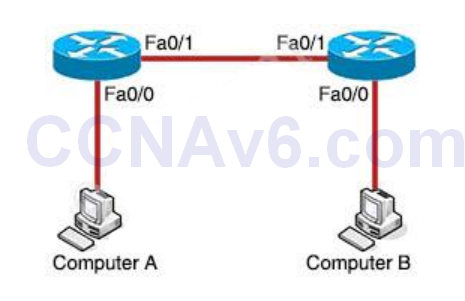- Which two statements about floating static routes are true? (Choose two)
- A. They are routes to the exact /32 destination address
- B. They are used when a route to the destination network is missing
- C. They have a higher administrative distance than the default static route administrative distance*
- D. They are used as back-up routes when the primary route goes down*
- E. They are dynamic routes that are learned from a server
Show (Hide) Explanation/ReferenceFloating static routes are static routes that have an administrative distance greater than the administrative distance (AD) of another static route or dynamic routes. By default a static route has an AD of 1 then floating static route must have the AD greater than 1. Floating static route has a manually configured administrative distance greater than that of the primary route and therefore would not be in the routing table until the primary route fails. - Which definition of a host route is true?
- A. A route that is manually configured
- B. A route used when a destination route is missing
- C. A route to the exact /32 destination address*
- D. Dynamic route learned from the server
Show (Hide) Explanation/ReferenceA host route for IPv4 has the mask /32, and a host route for IPv6 has the mask /128. If an IPv4 address is configured with a mask of /32 on an interface of the router, which is typical for loopback interfaces, the host route appears in the routing table only as connected (for example in the routing table we will see this line: “C 10.10.10.1/32 is directly connected, Loopback0”.Reference: https://www.cisco.com/c/en/us/support/docs/ip/ip-routing/116264-technote-ios-00.html
- When troubleshooting Ethernet connectivity issues, how can you verify that an IP address is known to a router?
- A. Check whether the IP address is in the routing table
- B. Check whether an ACL is blocking the IP address
- C. Check whether the IP address is in the CAM table
- D. Check whether the IP address is in the ARP table*
Show (Hide) Explanation/ReferenceIf the IP address exists in the routing table then we can say the local router knew the way to reach that destination. But this question wants to ask if the destination has communicated to the local router or not (“an IP address is known to a router”). Maybe it is a tricky question. - If Computer A is sending traffic to computer B, which option is the source IP address when a packet leaves R1 on interface F0/1?

- A. IP address of the R2 interface F0/1
- B. IP address of computer B
- C. IP address of R1 interface F0/1
- D. IP address of Computer A*
Show (Hide) Explanation/ReferenceIn all the way on the path, the source and destination IP addresses never change, only the source and destination MAC address are changed on each segment. - When is a routing table entry identified as directly connected?
- A. When the local router is in use as the network default gateway
- B. When the network resides on a remote router that is physically connected to the local router
- C. When an interface on the router is configure with an ip address and enabled*
- D. When the route is statically assigned to reach a specific network
- Router R1 has a static router that is configured to a destination network. A directly connected inference is configured with an IP address in the same destination network. Which statement a bout R1 is true?
- A. It refuses to advertise the dynamic route to other neighbors
- B. It sends a withdrawal signal to the neighboring router
- C. It disables the routing protocol
- D. It prefers the static route*
- Router R1 has a static route that is configured to destination network.A directly connected interface is configured with an IP address in the same destination network. Which statement about R1 is true?
- A. R1 refuses to advertise the dynamic route to other neighbors
- B. R1 prefers the static route
- C. R1 prefers the directly connected interface*
- D. R1 sends a withdrawal notification to the neighboring router
- In which situation would the use of a static route be appropriate?
- A. To configure a route to the first Layer 3 device on the network segment.
- B. To configure a route from an ISP router into a corporate network.
- C. To configure a route when the administrative distance of the current routing protocol is too low.
- D. To reach a network is more than 15 hops away.
- E. To provide access to the Internet for enterprise hosts*
CCNA 200-125 Exam: IP Routing 3 With Answers
Subscribe
0 Comments
